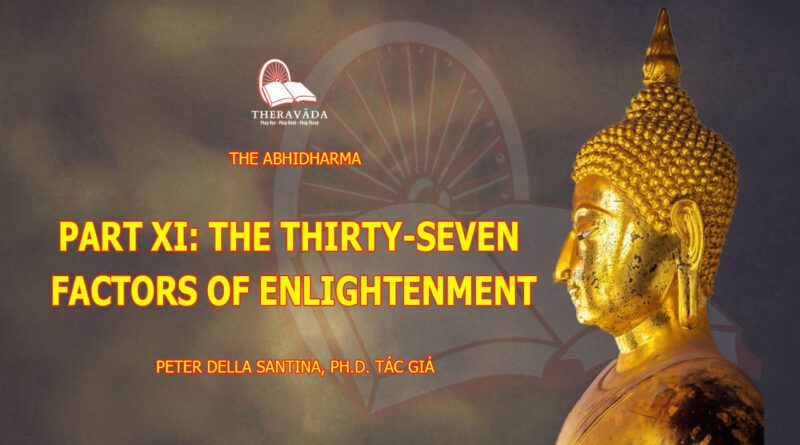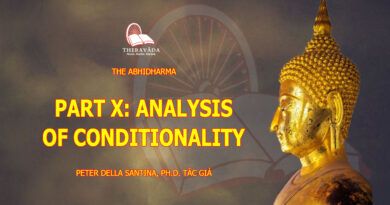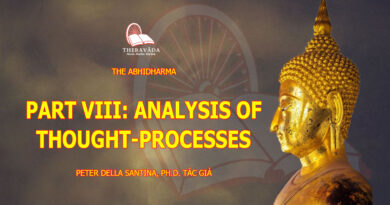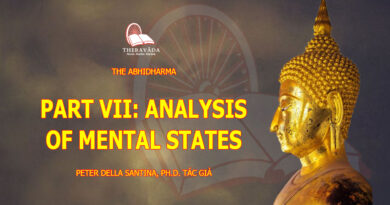THE ABHIDHARMA – PART XI: THE THIRTY-SEVEN FACTORS OF ENLIGHTENMENT
The thirty-seven factors conducive to enlightenment (bodhipakkhiya dhamma) are important for two reasons. First, according to tradition, they were recommended by the Buddha, shortly before his entry into final nirvana, as primary means of gaining enlightenment. Second, these factors form a fundamental part of the foundation of the Abhidharma, in that they belong to that category of teaching, like the teaching on the five aggregates, that comprises the Abhidharmic contents of the Sutra Pitaka.
Previously, we talked about the characteristics of the Abhidharma and the relation between Abhidharmic material and the contents of the discourses, or sutras. The factors conducive to enlightenment belong to this category of material, which is Abhidharmic in nature and yet found in the discourses. Thus they belong to the early period of Abhidharmic philosophy.
The thirty-seven factors of enlightenment are without doubt Abhidharmic in nature. All five characteristics of Abhidharmic material apply to them: (1) definition of factors, (2) relation of factors to other factors, (3) analysis of factors, (4) classification of factors, and (5) arrangement in numerical order (see Chapter 10).
The thirty-seven factors are classified under seven groups: (a) the four stations of mindfulness (satipatthana), (b) the four right efforts (sammappadana), (c) the four roads to power (iddhipada), (d) the five controlling faculties (indriya), (e) the five powers (bala), (f) the seven limbs of enlightenment (bojjhanga), and (g) the Noble Eightfold Path (atthangika magga). The Buddha called mindfulness the one way to the elimination of the afflictions. The Buddha has also said that the mind is the root of all virtues. The most important practice, therefore, is to discipline the mind. One can also understand the importance of mindfulness from the fact that mindfulness occurs in five of the seven groups that make up the thirty-seven factors conducive to enlightenment, and that the first of these groups is devoted exclusively to the four stations of mindfulness (satipatthana). Mindfulness is also taught in the Satipatthana Sutta (The Discourse on the Stations of Mindfulness), which occurs twice in the Buddhist canon. All this indicates the importance of mindfulness.
In recent years there has been a great resurgence of interest in the four stations of mindfulness both within the Theravada tradition, particularly in Burma, and also in the Mahayana tradition, where the importance of the four stations of mindfulness as a part of the practice of meditation has now come to be appreciated. One of the reasons these four stations have occupied such an important place in Buddhist meditation is that they lead to the realization of the three universal characteristics (impermanence, suffering, and not-self). Exactly how this works will become clearer once we enumerate the four stations: (i) mindfulness with regard to the body, (ii) mindfulness with regard to feeling, (iii) mindfulness with regard to consciousness, and (iv) mindfulness with regard to mental objects.
Mindfulness with regard to the body is more inclusive here than it is in the context of the forty traditional supports of meditation, where it occurs as one of the ten recollections but is restricted only to the body. Here it applies not only to mindfulness with regard to the body but also to mindfulness regarding the process of inhalation and exhalation, the elements of matter, the decomposing body, and so forth.
Mindfulness with regard to feeling refers to the emotional contents of personal experience, to feelings that are pleasant, unpleasant, or indifferent.
Mindfulness with regard to consciousness — or, to be more precise, mindfulness with regard to thought–implies observation of the arising and perishing of thoughts.
Mindfulness with regard to mental objects refers to the contents of consciousness, particularly concepts such as impermanence and the like.
With the first station of mindfulness, we exhaust the material dimension of personal experience, and with the three subsequent stations we exhaust the mental dimension of personal experience (i.e., the aggregates of consciousness, volition, perception, and feeling). The thorough application of mindfulness results in abandoning the three erroneous views (permanence, happiness, and self) and attaining insight into the three universal characteristics (impermanence, suffering, and not-self). Interpretations of the objects of the four stations of mindfulness vary according to the various traditions of Buddhist meditation. In general, however, the explanation here should be acceptable to most of the traditions.
Let us look at the four roads to power (iddhipada): (i) wish or desire, (ii) energy, (iii) mind or thought, and (iv) reasoning. These four factors are also found in the twenty-four modes of conditionality (see Chapter 9), where they are termed ‘predominant conditions’ (adhipati). Both the ‘roads to power’ and ‘predominant conditions’ clearly suggest the power of the mind to influence experience.
A simple example is the power to control, up to a certain point, the movements of our bodies and the exercise of our speech. This is a case of the undeveloped power of the mind, desire, energy, and reason to control physical phenomena. When these predominant factors are intensified by cultivation of the five factors of absorption (initial application, sustained application, interest, happiness, and one-pointedness) — particularly the intensification of one-pointedness, which occurs upon attaining the fifth stage of the form-sphere absorptions — they become roads to power.
Through intensification, the predominant factors lead to what are called mundane types of super knowledge and the supramundane knowledge. There are five types of mundane super knowledge: the ability to fly through the sky cross-legged, to walk on water, to move through the earth, to read the thoughts of others, and to recollect one’s former lives. The supramundane knowledge is knowledge of the destruction of the defilements (asava), ignorance, and so forth. This is perhaps why it is sometimes said that the four predominant conditions may be either mundane or supramundane. If they are directed toward the mundane sphere, they result in the five types of mundane super knowledge, whereas if they are directed toward the supramundane sphere, or nirvana, they result in penetration of the Four Noble Truths and in the destruction of the defilements.
Like the four roads to power, the five controlling faculties (indriya) — (i) faith, (ii) energy, (iii) mindfulness, (iv) concentration, and (v) wisdom — are also found in the twenty-four modes of conditionality. In the Book of Causal Relations (patthana), the five controlling faculties are defined as dominating factors. There is a very close connection between the five controlling faculties and the four roads to power, as indicated by their mutual presence in the modes of conditionality and their similarity in the sense of controlling, dominating, or mastering.
The five faculties are called ‘controlling’ because they are said to control or master their opposites: faith (or confidence) controls lack of faith (or doubt); energy controls laziness; mindfulness controls heedlessness; concentration controls distraction; and wisdom controls ignorance. Like the four roads to power, the five controlling faculties can only really control their opposites when they are intensified by the factors of absorption. For instance, faith can only function as a controlling faculty when it is strengthened by the presence of the three factors of absorption of interest, happiness, and one-pointedness; and wisdom can only function effectively when it is strengthened by initial application, sustained application, and one-pointedness. These five factors of absorption strengthen and intensify the five controlling faculties so that the latter can function effectively to propel one toward enlightenment. Similarly, the five controlling faculties strengthen the five factors of absorption. For instance, concentration strengthens interest and happiness. Thus the relationship between the two sets of factors is one of reciprocal support and intensification.
Although the five controlling faculties are indispensable in bringing about the transformation from a doubtful, lethargic, heedless, distracted, and ignorant mode of being to an enlightened mode of being, they must be cultivated in a balanced way. What this means is that within the five controlling faculties there are factors that balance each other. For instance, faith and wisdom are a reciprocal pair: if faith is allowed to dominate wisdom, this results in a weakening of one’s critical faculties, one’s intellectual powers of analysis and investigation; and if wisdom is allowed to dominate faith, this diminishes confidence to the point of uncertainty and a lack of initial commitment to practice. Similarly, if energy is allowed to dominate concentration, this leads to agitation, and if concentration is allowed to dominate energy, this leads to sloth and torpor.
Thus faith, energy, concentration, and wisdom must be developed and maintained in a balanced manner, and the faculty that enables one to do this is mindfulness. Mindfulness is the watchdog that ensures the proper reciprocal, balanced relationship between faith and wisdom, and between energy and concentration.
The next group of factors of enlightenment, the five powers (bala) — (i) faith, (ii) energy, (iii) mindfulness, (iv) concentration, and (v) wisdom — are numerically and terminologically identical to the five controlling faculties. These five factors are called powers because on this stage faith, energy, mindfulness, concentration, and wisdom become firm, steady, and powerful.
The Buddha indicated that the five controlling faculties and five powers are two aspects of the same thing, just as an island in the middle of a river can lead people to call one side of the river the eastern part and the other side the western part, even though the two parts of the river are one and the same. Similarly, the five controlling faculties and the five powers are one and the same. The five controlling faculties are potentialities that must be intensified and developed through their combination with the five factors of absorption. When they become firm and steady through this intensification, they can then be termed powers.
We might add that the five powers become absolutely unshakable only in the case of the noble ones (see Chapter 5). On becoming a stream-winner, for example, faith becomes an unshakable power because the fetter of doubt is removed.
Although only the five controlling faculties and five powers are listed in the thirty-seven factors, in the expanded Abhidharmic classification of the controlling faculties and powers, there are three more faculties added to the five already mentioned (mind, joy, and vitality), and two more powers (moral shame and moral dread, known collectively as ‘the guardians of the world’). Moral shame and moral dread are explained as one’s own sense of moral uprightness and fear of censure or blame. They are called guardians of the world because, when developed to the level of powers, they become guardians of wholesome actions.
The last group we will consider here are the seven limbs of enlightenment (bojjhanga): (i) mindfulness, (ii) investigation, (iii) energy, (iv) interest, (v) tranquillity, (vi) concentration, and (vii) equanimity. Mindfulness again appears as one of the factors, and again it leads the group, because it is with mindfulness that the way to enlightenment begins.
Thus it is through awareness of one’s situation that progress on the path begins. This progress is sustained through investigation — in this case, the investigation of factors.
Energy occurs here, as it did in the four roads to power, the five controlling faculties, and the five powers. Energy is essential to sustain the progress one makes along one’s spiritual path. All too often, our efforts are sporadic; we make a great effort for a short period of time and then relapse for a much longer time. If progress is to be sustained it must be steady, and energy contributes to steady, consistent progress along the path.
The fourth factor, interest, which is also one of the five factors of absorption, is suffused with happiness, although it can best be understood more as interest than as joy or rapture per se (see Chapter 4).
Tranquillity in this context is the tranquillity of mind that results from eliminating the afflictions of ignorance, ill-will, and attachment.
Concentration is synonymous with one-pointedness, which is one of the five factors of absorption.
Equanimity is the elimination of the mind’s tendency to wander. Like so many Abhidharmic terms, equanimity functions on a number of levels. At the level of feeling, it can be indifference. At the level of the cultivation of the Four Immeasurable meditations (brahmavihara), equanimity is even-mindedness toward sentient beings — the absence of attachment to near and dear ones, and the absence of aversion to enemies. In the analysis of personal experience in the teaching on the five aggregates, equanimity is the neutralization of the eight worldly conditions (happiness and pain, gain and loss, praise and blame, and fame and infamy). Here, in the context of the seven limbs of enlightenment, equanimity is that integrated and unshakable state of mind which is totally free of mind’s habitual tendency to wander.
These thirty-seven factors were codified, preserved, and taught by generations of masters for one reason only: they were found to be useful and beneficial in developing one’s mind, and particularly in aiding progress toward enlightenment. Whether we choose to concentrate on the four stations of mindfulness, the four efforts, the four roads to power, the five controlling faculties, the five powers, the seven limbs of enlightenment, or the Noble Eightfold Path, familiarity with these factors of enlightenment can manifestly and immediately aid our progress toward that goal.
Source: Budsas.net







